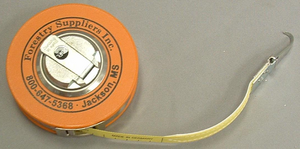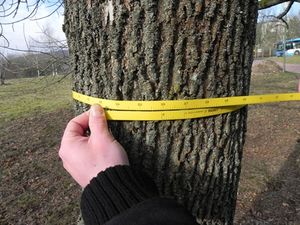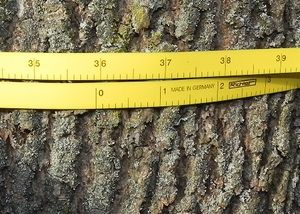Diameter tape
| (4 intermediate revisions by one user not shown) | |||
| Line 1: | Line 1: | ||
| − | {{ | + | {{Ficontent}} {{video|link=https://youtu.be/17NPkVXteiI}} |
| − | + | ||
Tree diameter can also be determined from the measurement of [[circumference]] <math>C</math>. Then, assuming a perfectly circular shape of the [[Tree Definition|stems]] cross section at the height of measurement, the diameter <math>d</math> is simply calculated as | Tree diameter can also be determined from the measurement of [[circumference]] <math>C</math>. Then, assuming a perfectly circular shape of the [[Tree Definition|stems]] cross section at the height of measurement, the diameter <math>d</math> is simply calculated as | ||
| − | :<math>d=\frac{C}{\pi}\,</math> | + | :<math>d=\frac{C}{\pi}\,</math> |
There are also diameter tapes from which the tree diameter can be directly read. Some diameter tapes are graduated on both sides, on one side with linear centimeter scale for reading circumference, whereas the other side reads the diameter scale. It is important, not to confuse the readings! | There are also diameter tapes from which the tree diameter can be directly read. Some diameter tapes are graduated on both sides, on one side with linear centimeter scale for reading circumference, whereas the other side reads the diameter scale. It is important, not to confuse the readings! | ||
| Line 17: | Line 16: | ||
Table 1 illustrates that with a simple and theoretic example: we imagine trees that have exactly <math>1m^2</math> of [[basal area]] but different elliptic shapes of their cross-sections. We are now interested what happens when we measure the perimeter and then infer to basal area of dbh assuming a circular shape. For the circle, perimeter <math>p_c=2{\pi}r</math>, and area <math>f_c={\pi}r</math>. The shape of an ellipse is defined by the two radii <math>a</math> and <math>b</math>. Then, the area of an ellipse is calculated by <math>f_e={\pi}ab</math>; there is no formula to calculate the perimeter of an ellipse <math>p_e</math> but it can only be approximated by | Table 1 illustrates that with a simple and theoretic example: we imagine trees that have exactly <math>1m^2</math> of [[basal area]] but different elliptic shapes of their cross-sections. We are now interested what happens when we measure the perimeter and then infer to basal area of dbh assuming a circular shape. For the circle, perimeter <math>p_c=2{\pi}r</math>, and area <math>f_c={\pi}r</math>. The shape of an ellipse is defined by the two radii <math>a</math> and <math>b</math>. Then, the area of an ellipse is calculated by <math>f_e={\pi}ab</math>; there is no formula to calculate the perimeter of an ellipse <math>p_e</math> but it can only be approximated by | ||
| − | :<math>p_e \approx \pi\left(a*b\right)\left(1+\frac{3t}{10+\left(\sqrt{4-3t}\right)}\right)\,</math> | + | :<math>p_e \approx \pi\left(a*b\right)\left(1+\frac{3t}{10+\left(\sqrt{4-3t}\right)}\right)\,</math> |
where | where | ||
| − | :<math>t=\left(\frac{a-b}{a+b}\right)^2\,</math> | + | :<math>t=\left(\frac{a-b}{a+b}\right)^2\,</math> |
Different ellipses are defined in Table 1 by different values of <math>a</math> and <math>b</math>, all having the same basal area of <math>1m^2</math>. | Different ellipses are defined in Table 1 by different values of <math>a</math> and <math>b</math>, all having the same basal area of <math>1m^2</math>. | ||
| Line 94: | Line 93: | ||
| − | A circle of <math>1m^2</math> has a radius of <math>0.5642m</math> and in this case the [[perimeter measurement]] leads exactly to the correct diameter value. However, if we have an elliptical cross-section with the two radii <math>a=0.6366</math> and <math>b=0.5m</math> and measure the perimeter, then the resulting diameter is slightly larger | + | A circle of <math>1m^2</math> has a radius of <math>0.5642m</math> and in this case the [[perimeter measurement]] leads exactly to the correct diameter value. However, if we have an elliptical cross-section with the two radii <math>a=0.6366</math> and <math>b=0.5m</math> and measure the perimeter, then the resulting diameter is slightly larger (<math>0.5704m</math>) and also the basal area is overestimated by about <math>2%</math>. For extreme elliptical shapes, this overestimation is considerable. For smaller deviations from the circular shape the overestimation is probably in an order of magnitude that does not have major practical relevance in [[forest inventory]]. But you should know that, from a theoretical viewpoint, this overestimation is always there. |
In many countries, the diameter tape is the most common [[:Category:Measurement devices|device]] used in measuring [[Tree diameter|tree diameters]], because it is small, handy and inexpensive. One should take care that the tape is correctly and horizontally positioned at the point of measurement; that it is not twisted and is set firmly around the tree trunk. The particular position of zero mark in different tapes is not standardized; therefore specific care should be taken to determine the zero mark on tape before the field measurement. | In many countries, the diameter tape is the most common [[:Category:Measurement devices|device]] used in measuring [[Tree diameter|tree diameters]], because it is small, handy and inexpensive. One should take care that the tape is correctly and horizontally positioned at the point of measurement; that it is not twisted and is set firmly around the tree trunk. The particular position of zero mark in different tapes is not standardized; therefore specific care should be taken to determine the zero mark on tape before the field measurement. | ||
| Line 109: | Line 108: | ||
{{SEO | {{SEO | ||
|keywords=diameter tape,tree diameter,diameter at breast height,forest inventory,tree measurement,standing tree sampling | |keywords=diameter tape,tree diameter,diameter at breast height,forest inventory,tree measurement,standing tree sampling | ||
| − | |descrip=The diameter tape determines the tree diameter by | + | |descrip=The diameter tape determines the tree diameter by measuring its circumference. |
}} | }} | ||
[[Category:Measurement devices]] | [[Category:Measurement devices]] | ||
Latest revision as of 09:39, 12 March 2021
Tree diameter can also be determined from the measurement of circumference \(C\). Then, assuming a perfectly circular shape of the stems cross section at the height of measurement, the diameter \(d\) is simply calculated as
\[d=\frac{C}{\pi}\,\]
There are also diameter tapes from which the tree diameter can be directly read. Some diameter tapes are graduated on both sides, on one side with linear centimeter scale for reading circumference, whereas the other side reads the diameter scale. It is important, not to confuse the readings!
Circular shape is assumed when inferring from circumference to diameter. However, trees have never a perfect circular cross section; there are always irregularities. If we then assume that the stem has a circular cross section with the shortest perimeter for a given cross-sectional area, then we come to a systematic overestimation of the cross-sectional area and also of the diameter which is derived from this cross-sectional area.
Table 1 illustrates that with a simple and theoretic example: we imagine trees that have exactly \(1m^2\) of basal area but different elliptic shapes of their cross-sections. We are now interested what happens when we measure the perimeter and then infer to basal area of dbh assuming a circular shape. For the circle, perimeter \(p_c=2{\pi}r\), and area \(f_c={\pi}r\). The shape of an ellipse is defined by the two radii \(a\) and \(b\). Then, the area of an ellipse is calculated by \(f_e={\pi}ab\); there is no formula to calculate the perimeter of an ellipse \(p_e\) but it can only be approximated by
\[p_e \approx \pi\left(a*b\right)\left(1+\frac{3t}{10+\left(\sqrt{4-3t}\right)}\right)\,\]
where
\[t=\left(\frac{a-b}{a+b}\right)^2\,\]
Different ellipses are defined in Table 1 by different values of \(a\) and \(b\), all having the same basal area of \(1m^2\).
Table 1 Illustration of the effect of assuming a perfect circular cross section when determining basal area and dbh by tape-measurements (Kleinn 2007[1]).
Area 1m² r b a t Area Perimeter Ellipse r from Perimeter Area from Perimeter 0.5642 1.0000 3.5449 0.5642 1.0000 0.50 0.6366 0.0144 1.0000 3.5837 0.5704 1.0220 0.40 0.7958 0.1095 1.0000 3.8602 0.6144 1.1858 0.30 1.0610 0.3127 1.0000 4.6171 0.7348 1.6964 0.20 1.5915 0.6033 1.0000 6.5157 1.0370 3.3784 0.10 3.1831 0.8819 1.0000 12.7584 2.0306 12.9535
A circle of \(1m^2\) has a radius of \(0.5642m\) and in this case the perimeter measurement leads exactly to the correct diameter value. However, if we have an elliptical cross-section with the two radii \(a=0.6366\) and \(b=0.5m\) and measure the perimeter, then the resulting diameter is slightly larger (\(0.5704m\)) and also the basal area is overestimated by about \(2%\). For extreme elliptical shapes, this overestimation is considerable. For smaller deviations from the circular shape the overestimation is probably in an order of magnitude that does not have major practical relevance in forest inventory. But you should know that, from a theoretical viewpoint, this overestimation is always there.
In many countries, the diameter tape is the most common device used in measuring tree diameters, because it is small, handy and inexpensive. One should take care that the tape is correctly and horizontally positioned at the point of measurement; that it is not twisted and is set firmly around the tree trunk. The particular position of zero mark in different tapes is not standardized; therefore specific care should be taken to determine the zero mark on tape before the field measurement.
 remember!
remember!
- When applying a diameter tape we implicitly presume a circular shape of the cross sectional area! This is a model assumption and the final error occurring in case of an elliptic cross sectional area is a model error. In general the final results are only as good as the model we imply or in other words, are dependent on how good the model is able to describe the actual target variable diameter!
[edit] References
- ↑ Kleinn, C. 2007. Lecture Notes for the Teaching Module Forest Inventory. Department of Forest Inventory and Remote Sensing. Faculty of Forest Science and Forest Ecology, Georg-August-Universität Göttingen. 164 S.


